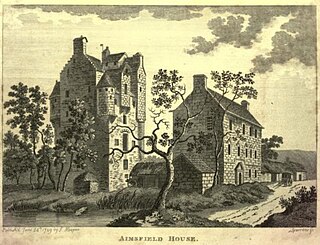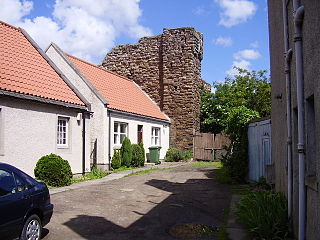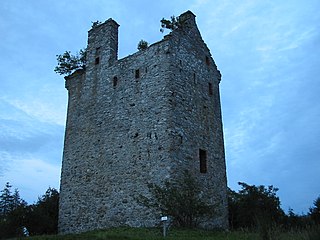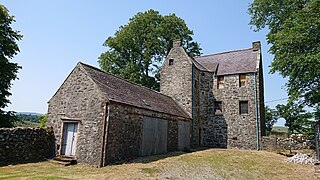Edinample Castle is a late 16th-century tower house on the southern shores of Loch Earn near Balquhidder in the Stirling council area of Scotland. It was designated as a Category A listed building in 1971. [1]
Edinample Castle is a late 16th-century tower house on the southern shores of Loch Earn near Balquhidder in the Stirling council area of Scotland. It was designated as a Category A listed building in 1971. [1]
The estate was granted to Colin Campbell, 6th Laird of Glenorchy in 1547 by Henry Stewart, 1st Lord Methven and his son, 'Black Duncan', Duncan Campbell of Glenorchy, (Donnchadh Dubh) probably built the castle in 1584. [1]
The castle takes the form of a Z-plan tower house and most likely incorporates an earlier tower in its eastern side. The rectangular main block measures 43 by 27 feet (13.1 by 8.2 m) and is three storeys and an attic high. Circular bartizans are corbelled out at the north and south corners at the second-storey level. Four-storey round towers, roughly 23 feet (7.0 m) in diameter, are at the northwestern and southeastern corners. Circular stair towers are corbelled out at the first-storey level at the northern junctures with the main block. [1] [2]
The interior and the roofs were remodelled around 1790. Sometime during the 18th or 19th century a two-storey porch and stairway was built against the northern face of the castle. A single-storey U-plan corrugated-iron structure was erected in 1870 on the eastern side, probably as an office. In the early 20th century a five-storey addition was built, completely enclosing the southeastern tower. The castle fell into a state of dereliction by the 1960s, but it was renovated for use as a private family home from about 1968–1998 by a series of owners. As part of the remodelling, all of the external additions, except for the office, were demolished.


Dunvegan Castle is located 1 mile (1.6 km) to the north of Dunvegan on the Isle of Skye, off the west coast of Scotland. It is the seat of the MacLeod of MacLeod, chief of the Clan MacLeod. Probably a fortified site from the earliest times, the castle was first built in the 13th century and developed piecemeal over the centuries. In the 19th century the whole castle was remodelled in a mock-medieval style. The castle is built on an elevated rock overlooking an inlet on the eastern shore of Loch Dunvegan, a sea loch.

Kilchurn Castle is a ruined structure on a rocky peninsula at the northeastern end of Loch Awe, in Argyll and Bute, Scotland. It was first constructed in the mid-15th century as the base of the Campbells of Glenorchy, who extended both the castle and their territory in the area over the next 150 years. After the Campbells became Earls of Breadalbane and moved to Taymouth Castle, Kilchurn fell out of use and was in ruins by 1770. It is now in the care of Historic Environment Scotland and is open to the public in summer.

Methven Castle is a privately owned 17th-century house situated east of Methven, in Perth and Kinross, Scotland.

Dunstaffnage Castle is a partially ruined castle in Argyll and Bute, western Scotland. It lies 3 miles (5 km) NNE of Oban, situated on a platform of conglomerate rock on a promontory at the south-west of the entrance to Loch Etive, and is surrounded on three sides by the sea. The castle and the nearby chapel ruin have been a Historic Scotland property since 1958. Both are Scheduled Ancient Monuments.

Muness Castle is located on Unst, which is one of the Shetland Islands of Scotland. The castle is 3 kilometres (1.9 mi) east of the village of Uyeasound. Unst is Scotland's most northerly inhabited island, and Muness is the most northerly fortalice in the British Isles. It was designated as a Scheduled monument in 1953 and is run as a museum by Historic Environment Scotland.
Dalmally is a village in Argyll and Bute, Scotland. It is near the A85 road and is served by Dalmally railway station.

Achallader Castle is a ruined 16th-century tower house under the shadow of Beinn Achaladair, about 3.5 miles north of Bridge of Orchy, Argyll and Bute, Scotland.

Amisfield Tower is a well-preserved tower house near Tinwald, about 5 miles (8.0 km) north of Dumfries, in Dumfries and Galloway, south-west Scotland. The castle has also been known as Hempisfield Tower. It is a Category A listed building.

Amhuinnsuidhe Castle is a large 19th-century private country house on Harris, one of the Western Isles of Scotland. It was designated as a Category A listed building in 1971 and is now operated as a hotel and shooting estate.

Birse Castle is located in the Forest of Birse, Aberdeenshire, Scotland. Originally a square tower house, it was rebuilt in the first decade of the 20th century into an L-plan structure. The 1930 addition of a new wing gave it a Z-plan. The building was designated a category B listed building in 1971.

Bavelaw Castle is a historic house in the City of Edinburgh Council area, Scotland. It is north of Hare Hill in the Pentland Hills, four miles west of Penicuik, and two miles south of Balerno, above Threipmuir Reservoir. It was designated as a Category A listed building in 1971.

Mearns Castle is a 15th-century tower house in Newton Mearns, East Renfrewshire, south of Glasgow, Scotland. It is a Category A listed building. The castle has been restored and is now part of the Maxwell Mearns Castle Church. It also gives its name to nearby Mearns Castle High School.

Tranent Tower is a ruined L-plan tower house dating from the 16th century, in Tranent, East Lothian, Scotland. The remains are protected as a scheduled monument.

Creich Castle is a ruined tower house near Creich, Fife, Scotland. The tower house and its associated buildings is a scheduled monument. There is a mention of a castle on the property in the 13th century, but it is uncertain what relationship that has to the existing structures. There is documentary evidence of a tower in 1553, but the existing structure either postdates that or has been heavily remodeled, judging by its architectural style.

Dally Castle is a ruined 13th-century stone motte-and-bailey fortress in Northumberland, and one of the first hall houses in Northumberland. It lies 5 miles (8.0 km) west of Bellingham Castle, and 4 miles (6.4 km) west of Bellingham on the Chirdon Burn, a tributary of the North Tyne. Dally Castle House was built in the 18th century next to the castle. Across the road lies a small flour mill used to grind wheat during the Napoleonic War.

Ochiltree Castle is a 16th-century tower house a few miles south east of Linlithgow in West Lothian, Scotland. It is also described as a farmhouse and lairds house. Along with its boundary wall, the castle was designated as a Category A listed building in 1971.
Farnell Castle is an oblong tower house dating from the late 16th century four miles south of Brechin, Angus, Scotland.

Invermark Castle is an oblong tower house dating from the 16th century, at the east of Loch Lee, Angus, Scotland. It is near the head of Glen Esk.

Earlstoun Castle, sometimes spelled Earlston Castle, is a derelict tower house near St John's Town of Dalry in Dumfries and Galloway, Scotland. Built in the late sixteenth century, it was home to members of the Gordon family, including William Gordon of Earlston who was killed at the battle of Bothwell Bridge. It is unusual for a tower house of its age for its lack of defensive arrangements: it has no gun loops, its roof is without a parapet or corner turrets, and it lies in open ground without natural defences.